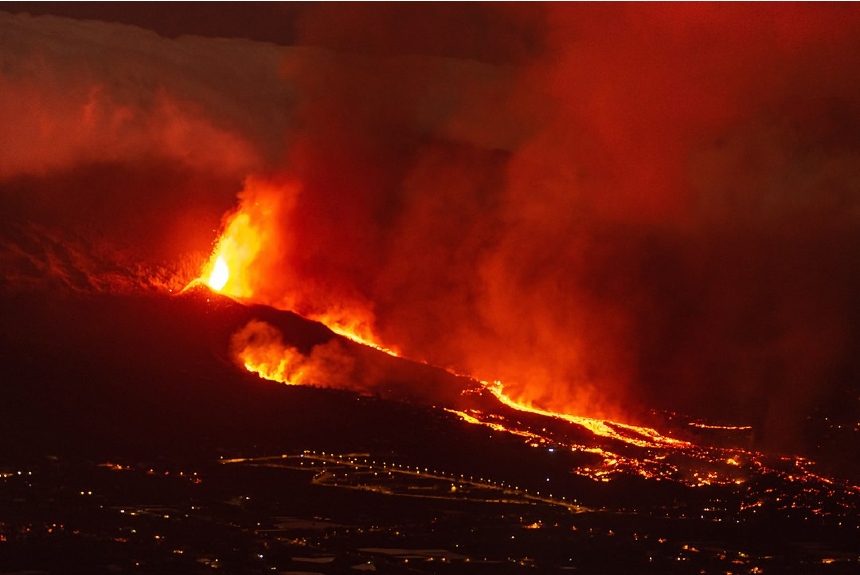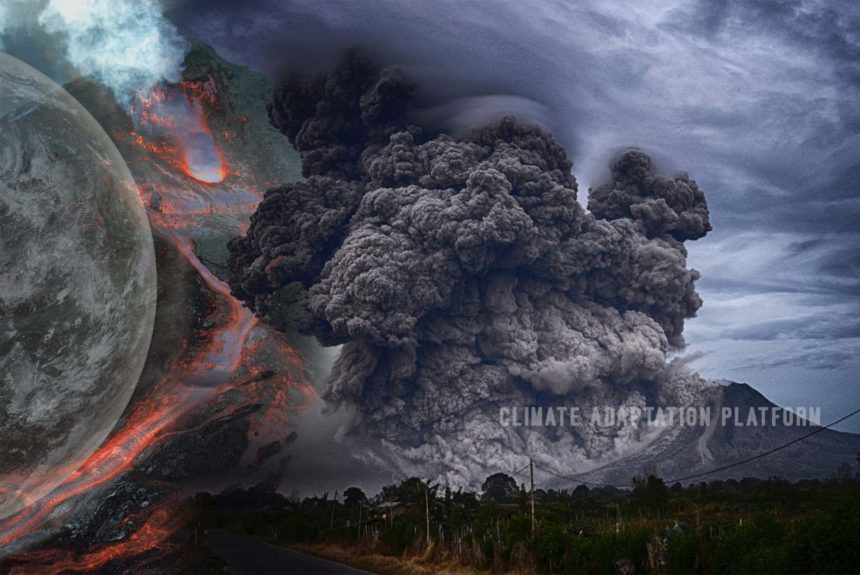On 19 September 2021, the world witnessed the eruption of the Cumbre Vieja volcano on Spain’s La Palma Island, which has been inactive for 50 years. As of writing, the volcano continues its eruption episodes.
Volcano Discovery reports that on September 22-23, the eruption was characterized by near-continuous, rapidly pulsating, and moderately tall lava fountains from the main vent, along with large lava bubble explosions and associated shock waves (La Palma volcano, 2021).
On March 19, six months before the Cumbre Vieja eruption, a volcano on the Reykjanes Peninsula in southwest Iceland erupted after being dormant for 800 years, Andrews (2021) writes.
Gamillo (2021) shares:
Las Palma’s volcano continues to be active and has since burnt more than 2000 acres of land. Thousands of residents have also fled the island. The plumes of ash and gases called an eruption column have spread across the Atlantic Ocean. The European Space Agency also released an image showing that sulphur dioxide plumes travelled towards northern African and southern Europe, eventually hitting some parts of north and western Europe.

Scientists from the Copernicus Atmospheric Monitoring Services have also been monitoring the long-range transport of large plumes of sulphur dioxide over thousands of kilometres that have travelled over North Africa, Europe, and the Atlantic to the Caribbean (Copernicus tracks, 2021).
Agencia EFE reports that the La Palma volcano has spewed some 250,00 tons of sulphur dioxide into the atmosphere (La Palma volcano spews, 2021).
Is it bad for the climate because volcanic eruptions release enormous amounts of carbon dioxide and other gases, particularly sulphur dioxide?
According to NASA, volcanic eruptions are often discussed concerning climate change because they release CO2 (and other gases) into our atmosphere.
What do volcanoes (2021) explains further:
However, human contributions to the carbon cycle are more than 100 times those from all the volcanoes in the world – combined. In comparison, while volcanic eruptions do cause an increase in atmospheric CO2, human activities emit a Mount St. Helens-sized eruption of CO2 every 2.5 hours and a Mount Pinatubo-sized eruption of CO2 twice daily.
The most significant possible eruptions come from super-volcanoes like Yellowstone or Mount Toba (which erupt very rarely, about every 100,000 to 200,000 years or more). Still, the total annual CO2 emissions from human activities is like one or more Yellowstone-sized super-eruptions going off every year. Essentially, CO2 emissions from human activities dwarf those of volcanoes.
The USGS article, “Volcanoes Can Affect Climate“, explains that sulphur dioxide injected by the eruption “can cause global cooling, while volcanic carbon dioxide, a greenhouse gas, has the potential to promote global warming.”
It says further:
The most significant climate impacts from volcanic injections into the stratosphere come from converting sulphur dioxide to sulfuric acid, which condenses rapidly in the stratosphere to form fine sulphate aerosols. The aerosols increase the reflection of radiation from the Sun back into space, cooling the Earth’s lower atmosphere or troposphere.
Several eruptions during the past century have caused a decline in the average temperature at the Earth’s surface of up to half a degree (Fahrenheit scale) for periods of one to three years,” citing the Mount Pinatubo eruption on June 15, 1991, causing what is believed to be the “largest aerosol disturbance in the stratosphere in the twentieth century.”
But the eruptions of Krakatau in 1883 and Tambora in 1815 had a much more significant climate impact, cooling the Earth’s surface for three years by as much as 1.3 degrees F.
A 2009 study, published in the National Institute of Environmental Health Science, shows that although volcanic eruptions can have a cooling effect on the Earth’s surface, the frequency of volcanic eruptions and the amounts of sulphur dioxide emitted negatively affects the climate – causing very rapid warming. Current volcanic events happen once every 80 years, giving ample time for sulphur dioxide to oxidate.
Source Citation:
La Palma volcano eruption 2021: Sep 22-23, first impression. (n.d.) Volcano Discovery. Retrieved from https://www.volcanodiscovery.com/photos/lapalma/2021eruption/0922-23/firstimpressions.html
Andrews, R. (2021, March 23). Eruption in Iceland may mark the start of decades of volcanic activity. National Geographic. Retrieved from https://www.nationalgeographic.com/science/article/eruption-in-iceland-may-mark-start-of-decades-of-volcanic-activity
Gamillo, E. (2021, November 1). Spain’s La Palma Volcano Continues to Erupt and Spews Ash. Smithsonian Magazine. Retrieved from https://www.smithsonianmag.com/smart-news/spains-la-palma-volcano-continues-to-erupt-and-spew-ash-180978965/
Copernicus tracks ongoing emissions from La Palma volcano across Europe and the Caribbean. (2021, October 21). Copernicus. Retrieved from https://atmosphere.copernicus.eu/copernicus-tracks-ongoing-emissions-la-palma-volcano-across-europe-and-caribbean
La Palma volcano spews some 250,000 tons of sulfur dioxide. (2021, October 5). EFE. Retrieved from https://www.efe.com/efe/english/portada/la-palma-volcano-spews-some-250-000-tons-of-sulfur-dioxide/50000260-4645292
What do volcanoes have to do with climate change. (2021) NASA. Retrieved from https://climate.nasa.gov/faq/42/what-do-volcanoes-have-to-do-with-climate-change/
PHOTO CREDIT: Erupción volcánica de La Palma de 2021 By Eduardo Robaina, CC BY-SA 3.0, https://commons.wikimedia.org/w/index.php?curid=110322497



Leave a Reply